One (small) advantage B100 has over V3 Mono is that B100 has greater gain variability, especially for balanced connection users. I have been looking for an amp with this performance with lower gain than V3 Mono that does not rely on volume attenuation (e.g. ZA3). The B100 will do this.
As for the reason why, it has to do with me relying on the DAC inside my R6 Pro II DAP and also using the DAP to control volume. If I use an amplifier with excessive gain (such as ZA3 with volume dial maxed out), there is a strange buzz/hum emitted whenever the DAC is not actively decoding material (so when the DAP is stopped/paused, and even momentarily between tracks). Once I lower the gain at the amp (in my case, by turning the volume dials on my ZA3s to 12:00 position), I can set gain to High and also raise the volume higher on the DAP, and that weird & distracting inter-track hum gets pushed below audible noise floor.
The other option (which I am relying on temporarily until my B100s come in) is to utilize the passive preamp in my Schiit Freya+ to control volume and keep the gain and volume maxed in the DAP, but ideally I would like to eliminate this unit entirely from the chain and take advantage of the volume control in the DAP (which, don't worry, has a user-adjustable cap).
The B100's lower gain settings/options (which do not rely on a variable attenuator) would be the ideal solution for this, allowing me to max out the digital domain dynamic range while still utilizing it for volume control, and minimizes the amount of equipment in the chain.
-Ed



